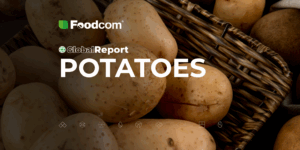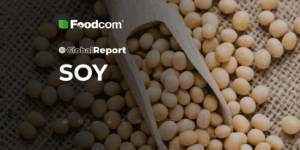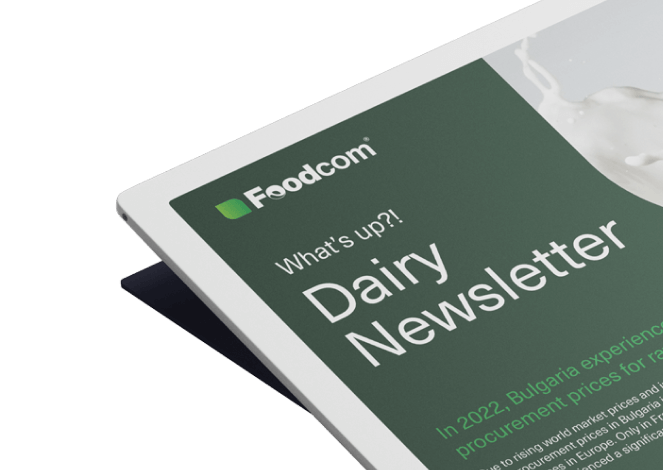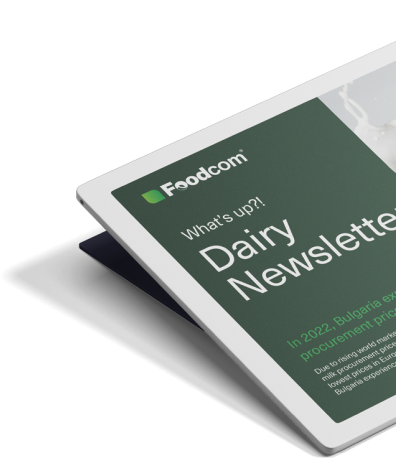- After a dynamic start to the year, the casein market stabilised thanks to improved availability of raw materials from Oceania and Europe.
- Trade is shifting towards long-term contracts.
- Asia maintains high demand, Oceania dominates exports, and Europe strengthens its position in the premium product segment.
- Caseinates and functional proteins are playing an increasingly important role – they are beginning to set the direction and margins of the market for the coming years.
Market dynamics
The beginning of 2025 was marked by limited supply, with lower raw material availability from Oceania and Western Europe keeping acid casein prices in the range of €5,900-€6,200/MT and rennet casein around €5,600-5,900/MT. The food sector maintained stable purchasing levels, especially in the high-protein and sports nutrition segments, while industrial demand remained stable, although customers remained sensitive to higher raw material costs.
The market remained tight in the second quarter: inventories were limited and sustained strategic demand lifted average transaction levels.
The situation gradually balanced out in the second half of the year. The production season in New Zealand improved raw material availability, which put pressure on a slight price correction and resulted in declines in US spot prices in October. Rennet casein maintained average trading levels close to EUR 5 800/MT. In Europe, trading was quieter, with sour and rennet casein quotations oscillating in the EUR 5 900-6 200/MT range. Activity on the spot market was limited. At the same time, lower transport costs and more predictable supplies from Oceania supported a gradual recovery in industrial demand.
As we enter the fourth quarter, the market remains under supply pressure due to the abundance of raw material in Oceania and the US, and most participants expect prices to remain stable or slightly declining until the end of the year. The casein market in 2025 is becoming more predictable, with less wild swings, more planning and stability in trade, although the global price competitiveness of the US has weakened.
Regional Analysis
Europe
The casein market in Europe remains stable, albeit with a clear split between the food and industrial segments. Favourable trading conditions persisted in the first half of the year, with limited product availability supporting prices and demand from protein food and nutritional manufacturers remaining strong. In the third quarter, the market became more balanced. Increased production in several European Union countries improved raw material availability, which stabilised quotations and increased competition among suppliers. The average unit CIF import price for casein (HS 350110) in Italy (a key market) in January-July 2025 was €6.61/Kg (€6 610/MT), down 1.8% year-on-year.
Casein trading in Europe is increasingly based on long-term contracts and stable supply chains, with the share of spot transactions steadily declining. In the final months of the year, pressure on producer margins was caused by higher energy costs (up 1.2% in the four weeks to October 2025) and logistics. Price competition remains limited due to balanced demand. Imports from Oceania and Asia remain moderate, affecting price elasticity.
North America
In 2025, the North American casein market remains small in terms of production, but clearly buoyant in the areas of trade and distribution. In the first few months of the year, high raw material costs combined with continued demand from the food and nutraceutical industries kept prices close to European levels. The United States, with limited production of its own, relied mainly on supplies from Oceania and Europe, which encouraged the development of long-term contracts and the maintenance of predictable trade relations.
In the second half of the year, the market gradually levelled off. Purchasing activity in the food processing or nutritional sector remained stable, while higher inventories and greater availability of raw material from New Zealand and Ireland eased pressure on prices. However, the market remained sensitive to changes in the dollar exchange rate. Despite these factors, the market situation remains balanced; demand remains stable and volatility in quotations is limited, favouring contracting in the final months of the year.
Oceania
In 2025, Oceania reaffirms its key role in the global casein trade. During the early months of the production season in New Zealand, supply remained limited, keeping quotations high. As the middle of the year approached, increased production in the region (in New Zealand, a 6.5% y/y increase in milk production in June-July 2025/2026) allowed for a slight reduction in prices and shorter delivery times, improving trade liquidity with North America and Europe.
In the second half of the year, the market maintained a steady pace of exports, despite periodic fluctuations in Australia’s dairy commodity supply (3.4% decline in milk production in 2025/2026). Strong demand from Asia and the Middle East absorbed a significant proportion of volumes. New Zealand producers remained cautious about entering into long-term contracts, preferring quarterly sales. As a result, casein quotations in Oceania remain within a narrow and predictable range, and the region maintains a reputation as the most stable supplier in the global dairy protein chain.
Asia
The Asian market remains one of the main destinations for casein in 2025, although the dynamics clearly differ between China, India and Southeast Asian markets. In the first half of the year, importers focused on securing supply in quarterly contracts, which kept quotations at the upper end of the ranges. The protein food and nutraceutical segments remained particularly active, while industrial buyers were more cautious, preferring contract volumes to spot volumes. The Asia-Pacific region is projected to be the fastest growing market in terms of CAGR (6.4% over 2025-2030).
Since the third quarter, the market has entered a phase of greater balance between supply and demand. Increased availability of the commodity from exporters outside the region has translated into more predictable delivery windows and narrower price ranges in transactions. At the start of the fourth quarter, quotations remain consistent with international benchmarks (USA, Oceania).
Middle East and North Africa
The Arab and African markets remained one of the key destinations for casein exports from Oceania and Europe. In the first half of the year, demand was mainly concentrated in countries with a developed food industry (i.e. Saudi Arabia, the United Arab Emirates or Egypt), where growing consumption of high-protein products increased demand for dairy raw materials. Import prices in quarterly contracts remained close to global levels. Oceania suppliers maintained their dominant position, while European exporters competed mainly with flexibility of delivery and shorter lead times.
In the second half of the year, the market situation stabilised due to improved raw material availability, as well as a decrease in sea transport costs. Demand in the region remains resilient to moderate price fluctuations, particularly in the nutritional, instant food and clinical nutrition segments. As a result, casein prices in the Middle East and North Africa remain within a narrow and predictable range, and the region is consolidating its position as a stable, albeit increasingly competitive, market with growing potential through 2026. The casein and caseinates market in the MENA region is forecast to grow at a CAGR of 2.0% between 2024 and 2035.
Trends and forecasts
After months of relative stability, the casein market enters the last quarter of 2025 in an orderly rhythm. Sustained demand from the protein food, sports nutrition and speciality products industries supports stable quotations. The market for casein and caseinates is expected to grow at a CAGR of 4.26% between 2025 and 2030. As the balance between the supply and demand side improves, the market shows little price volatility, with an increasing proportion of volumes being realised under long-term contracts.
Diversification of supply sources is becoming one of the key end-of-year trends. Importers are spreading their purchases between Oceania, Europe and North America, reducing the risks arising from seasonality of production or rising transport costs. This trading pattern increases the purchasing flexibility of market participants, while pressure on spot prices remains minimal – especially in October and November, when the balance between availability and demand is maintained.
The global balance sheet is also affected by the stabilisation of energy and freight costs. Lower oil prices, greater container availability and improved sea lanes have improved the fluidity of the supply chain between Europe-Asia and Oceania-Middle East. This, in turn, facilitates the planning of end-of-year contracts and also helps to maintain margins for producers and exporters.
Classic sour casein maintains a stable but slightly smaller share of global trade than higher-processed products, especially caseinates and functional proteins. Acid casein is expected to maintain the largest market share, estimated at 52% in 2025. Manufacturers are increasingly directing capacity towards these categories (caseinates), responding to demand from the diet food segment.
The overall market picture indicates that the end of 2025 will be marked by balance and moderate trading activity. Quotations remain stable, while market participants are mainly focused on securing contracts until the end of the year. Industry sentiment can be described as cautiously optimistic – there are no signs of sudden changes and the casein market maintains its reputation as one of the most predictable dairy protein segments.


The casein market in 2025 is primarily a question of security of supply and product structure. We are seeing strong price pressure from historically high supply from Oceania, which naturally depresses spot quotations, especially as the US export market has lost its competitiveness. It is crucial for companies to now focus on diversifying sources, securing volumes with long-term contracts. But the most important change is the role of caseinates: the future profitability of the industry lies in products with higher functionality and solubility, not in raw casein. It is they, not the base raw material, that will generate higher margins in 2026
Global Reports from Foodcom S.A.
Curious about what’s next for casein? Discover the latest trends and insights that will shape the final months of 2025. Visit our blog as we regularly update our Global Reports. Stay up to date with Foodcom S.A.
![Casein market overview 2025 [Global Report] Casein market overview 2025 [Global Report]](https://foodcom.pl/wp-content/uploads/2025/10/global-report-butter-min.png)


![Przegląd rynku lecytyny rzepakowej 2024 [Global Report] Przegląd rynku lecytyny rzepakowej 2024 [Global Report]](https://foodcom.pl/wp-content/uploads/2024/11/rapeseed-lecithin-global-report-300x150.png)




